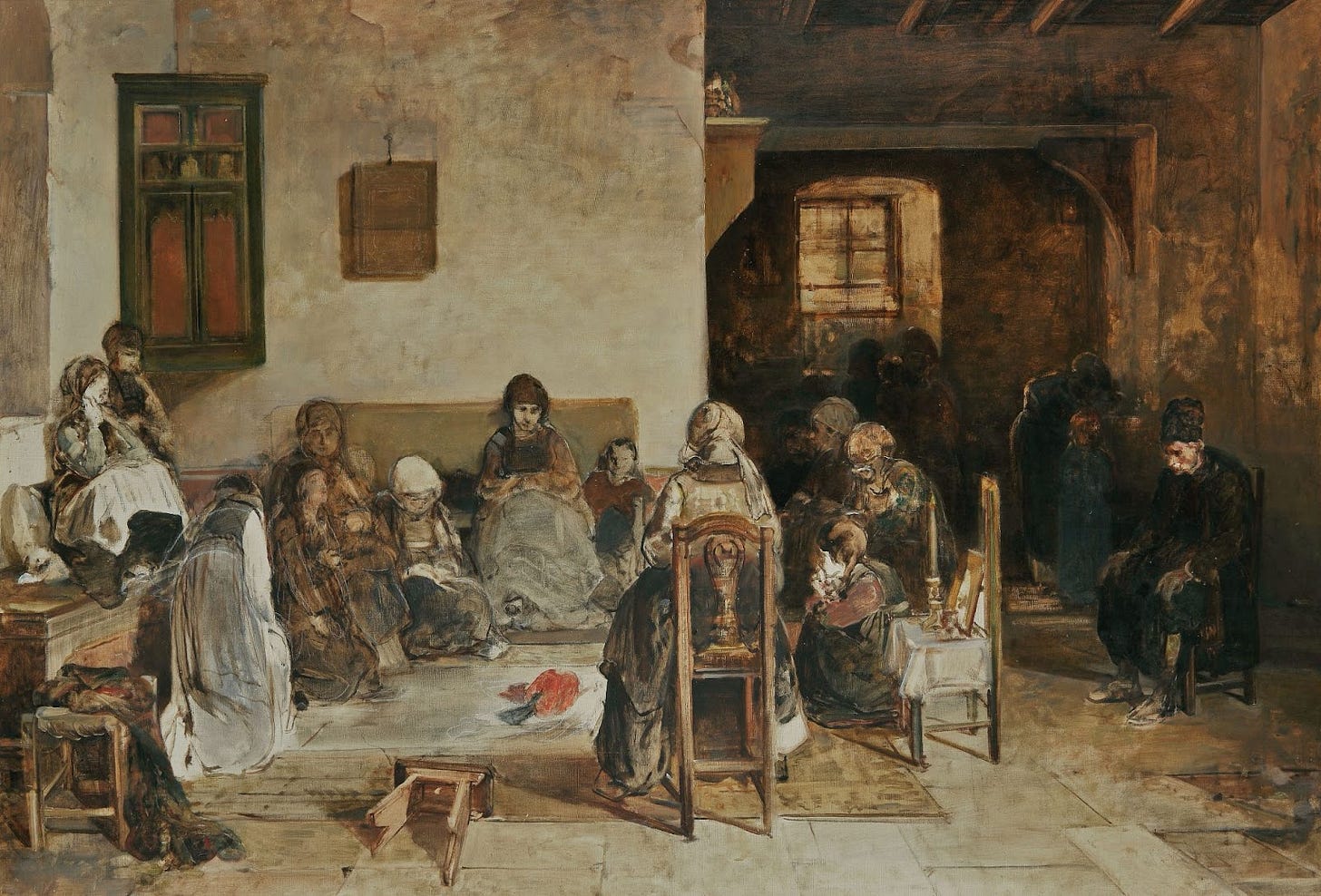
View
In Tolkien’s “The Return of the King”, there is one point in particular when all hope seems lost. Frodo and Sam are in the middle of the evil, barren, ashen land of Mordor. Frodo bears the ring of power, or the ring of doom, which is becoming too heavy and dark to bear. They no longer think they will make it to Mt. Doom, the only place the ring can be destroyed, the only way the shadow of evil can be vanquished. They have seen from hiding uncountable evil armies march out from Mordor and they believe that all their friends and loved ones are lost and their homeland is covered by the spreading shadow of evil. As Frodo lay nearby exhausted by the burden and the darkness, Sam looked up to the night sky from their place of hiding.
There, peeping among the cloud-wrack above a dark tor high up in the mountains, Sam saw a white star twinkle for a while. The beauty of it smote his heart, as he looked up out of the forsaken land, and hope returned to him. For like a shaft, clear and cold, the thought pierced him that in the end the Shadow was only a small and passing thing: there was light and high beauty forever beyond its reach.
(Tolkien, The Return of the King)
I shared the description and the passage above at a funeral for someone in my family who was much loved by me and many others. It seemed to fit, to express something - a barren darkness, a beauty and a hope lost amidst the promise of ultimate hope and beauty for one who has passed from death to life. The light and high beauty that she was experiencing and that was offered to all of us. Even if and when everything falls apart, there is a light and high beauty forever beyond the reach of this darkness.
Tolkien could have just said that in a sentence or two - something like I just did but likely better. But it is here, 800 or so pages into an epic trilogy, in this point of the story, with these characters we have come to know - that we can truly see it clearly … that we can experience something of this ultimate hope within darkness that we couldn’t with only a few simple sentences to work with. We can apprehend the truth of that theological proposition through art in a way we couldn’t otherwise.
That is one of the things art does. Art is for seeing.

Agnes Callard is an Associate Professor of Philosophy at the University of Chicago. In an article about art as a way of seeing, she relates that she was surprised to realize just how much literature there is in the reading assignments for her philosophy classes.
Looking back, I am surprised by how many pages of literature I have assigned over the years, far more than is the norm in college philosophy classes. I never formulated a plan to do so; I never self-consciously aimed for interdisciplinarity. How did my syllabi wind up populated by so many novels, stories, poems and plays?
I don’t believe Dr. Callard and I have the same theological beliefs or commitments. I am not sure, in the sense that I have them, that she has any. She does see the inescapable role this literature plays in understanding philosophy - in seeing what needs to be seen in order to grapple with the reality of life that philosophy seeks to engage.
I do acknowledge that great art affords us access to distinctive aesthetic pleasures, but I don’t see it as my job to expose students to them. My goal in constructing my syllabus is neither to improve their moral character, nor to offer them literary entertainment. Rather, the situation is this: the topic of the course requires reference to something that doesn’t show up clearly outside the space of artistic fiction. My hand is forced, because without the novels my course omits something that I see as crucial to understanding death, or self-creation, or courage, or self-consciousness.
I am talking about evil.
There are many complex theories about the nature and function of art; I am going to propose a very simple one. My simple theory is also broad: it applies to narrative fiction broadly conceived, from epic poems to Greek tragedies to Shakespearean comedies to short stories to movies. It also applies to most pop songs, many lyric poems and some—though far from most—paintings, photographs and sculptures. My theory is that art is for seeing evil.
I am using the word “evil” to encompass the whole range of negative human experience, from being wronged, to doing wrong, to sheer bad luck. “Evil” in this sense includes: hunger, fear, injury, pain, anxiety, injustice, loss, catastrophe, misunderstanding, failure, betrayal, cruelty, boredom, frustration, loneliness, despair, downfall, annihilation. This list of evils is also a list of the essential ingredients of narrative fiction.
Agnes Callard, Art is for Seeing Evil, The Point, July 15, 2022
Her point is well made. Art is for seeing evil. It is difficult to portray the truth of and to grapple with the reality of hunger, fear, injury, pain, anxiety, injustice, loss, catastrophe, misunderstanding, failure, betrayal, cruelty, boredom, frustration, loneliness, despair, downfall, and annihilation without it. To see these things clearly, art is often necessary.
Her point is well made, but a bit too restrictive. Art is for seeing evil. And beauty. And truth. Art is for seeing the transcendent, the eternal, and the ultimate. It is for seeing the truth. The best art does this by revealing the transcendent that is there, or that is just below the surface in our everyday experience. The transcendent we often miss as we go about our lives. But when we want to see it or need to express it, we often turn to art - to the artistic expression of deeper truth through story, in particular. But also through paintings, like the portrait above. The loss of a son at sea we understand as tragedy. But seeing it artistically expressed gives us a deeper sense of that tragedy. And a deeper sense of all tragedy through the artistic expression of that one single tragedy.
C.S. Lewis wrote about the promise of ultimate beauty often. But it is in a simple poem where we see him convey it most clearly.
At times, here in The Embassy, I will mention movies or books for this very reason. I could write a few paragraphs about alienation and loneliness and the self-protective stance in the world that can result. Or I can tell you to watch Lars and the Real Girl (as I did here) to “see” it - and to see how a redemptive movement can come from that place.
Art is for seeing.

Art is for seeing, and so we aren’t surprised to find it in the Bible. Jesus used story (as one example) to express these transcendent realities in his many parables. He might start with “the kingdom of heaven is like …” and tell a story or two about planting seeds. Or, in response to a question (“who is my neighbor?”) he tells a different story about a man running into some trouble on a road. In these little stories, Jesus is fulfilling a prophecy (artistically expressed in psalm) that he will reveal or unveil what has been hidden.
Jesus spoke all these things to the crowd in parables; he did not say anything to them without using a parable. So was fulfilled what was spoken through the prophet:
“I will open my mouth in parables,
I will utter things hidden since the creation of the world.”
(Matthew 13:34-35 - see also Psalm 78)
Art is for seeing.
But it can’t force us to see. If we have our eyes closed, as it were, the best art, the truest expression, the deepest portrayal will be fruitless. It is sometimes said that beauty is in the eye of the beholder. I believe there is objective beauty, but I do think there is a sense in which beauty is in the eye of the beholder - or not in the eye of the one who will not behold it. Jesus said as much, when he was asked why he spoke in parables in this same passage. He was, at the same time, fulfilling a different prophecy. He spoke to reveal, but to reveal in a way that left it up to us whether it would be revealed or concealed.
This is why I speak to them in parables:
“Though seeing, they do not see;
though hearing, they do not hear or understand.
In them is fulfilled the prophecy of Isaiah:
“‘You will be ever hearing but never understanding;
you will be ever seeing but never perceiving.
For this people’s heart has become calloused;
they hardly hear with their ears,
and they have closed their eyes.
Otherwise they might see with their eyes,
hear with their ears,
understand with their hearts
and turn, and I would heal them.
(Matthew 13:13-15)
Jesus often would say, after teaching, perhaps after telling one of these stories, that those who had “ears to hear, let them hear.” Art is for revealing, but it can also conceal. Art is for seeing, but it can also be for not seeing. Art is a divine vehicle for transcendence. But seeing it or not seeing it is up to us - in art and in life.
Links
Art is for Seeing Evil - Agnes Callard - The Point Magazine
All the Advantages are All the Disadvantages - The Embassy (referencing Lars and the Real Girl)
Some examples:
Tell all the truth but tell it slant - Emily Dickinson (mentioned in the On Culture podcast)
“Hope” is the thing with feathers - Emily Dickinson (also mentioned)



